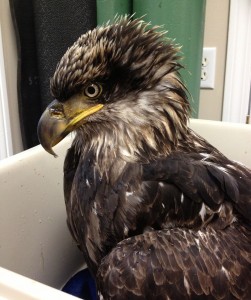WE’RE ALL DUNROAMIN’
The Eagle Has Landed

That was quite an improvement over his condition when the eagle landed at the clinic. He (or maybe she) had been found in a snow bank near Woodstock and was transported to the clinic for care since he was hypothermic and close to death. Once his body temperature was returned to normal, he was able to stand but not hold his head up. There were no visible wounds on his body and his x-rays were normal. His vet expected to find wing injuries since he allowed them to droop, but there were no fractures found in their 5-6 foot span.
Within 36 hours, although he was still lethargic, he would accept raw moose meat or raw salmon from the long barbeque tongs that were used to present food to him. We were very excited by this but still uncertain as to the cause of his problems. Fortunately, the Atlantic Wildlife Institute in Sackville has been able to survive (just barely) and they were able to advise Talon’s vet. They strongly suspected lead poisoning.
At great personal risk, Talon’s vet and her courageous veterinary technicians were able to draw a blood sample without injury to either side. (I have seen an adult bald eagle put its talons completely through a vet’s hand, and all vets know that if you stress a bird too much, it will die on you.) The sample confirmed that the eagle was suffering from lead poisoning. With the diagnosis confirmed, Talon was driven by a volunteer to a facility where experts could, well, get the lead out, I guess. It was a matter of us getting the lead out to get the lead out. The sooner it is removed, the more likely the raptor is to survive.

Although it has been illegal to use lead shot when hunting wildfowl since 1991, it is still used in hunting most other species. Lead poisoning affects many other wildlife species including loons, ducks, geese, pheasants and raccoons. Any species that ingests lead shot or the bullet fragments found in carcasses (many fragments are too small to feel or taste) can be affected by the lead.
Wildlife rehabilitation specialists say that if they do not find any broken bones when they receive an eagle lead poisoning is the next most-likely cause of the problem. Many do not survive or are not found early enough to be successfully treated.
Watching that beautiful bird struggle to maintain its upright stance and fight for survival and reading about the far-reaching toxic effects of lead shot has made me wonder why hunters and fishermen do not use some other less toxic metal in their ammunition and in their fishing gear.
